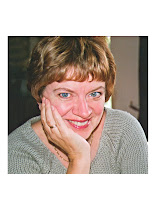
I saw this last night, in glorious 3D, with special specs, such as I haven't used since I was a child. Not the cardboard framed, one red, one green lens effort of back then but something more like regular shades. We must have been quite a cool-looking audience; in fact the photographer from Laika took a picture of us all specced up.
It was a visually stunning realisation of a book that just begged to be made into a film.
At first it was a bit of a shock to hear Dakota Fanning voicing Coraline but of course it made good economic sense for her to be American and it's an American film company. The second shock was the arrival of a character who doesn't appear in the book - Wyborne (Wybie) Lovat - whose grandmother owns the house.
He serves two functions: a sounding board for Coraline, who would otherwise have had to spend a lot of time talking to herself and someone for the boy viewers to identify with.
Once past these changes, I was struck by the film's fidelity to the book. They both have the very strong USP of the little girl who goes through a door in the wall of her parents' new apartment and finds an alternative mother and father in the one next door.
At first they seems a refreshing change, since they actually have time for Coraline, as well as cooking her favourite food and creating a wonderful garden for her to play in. This is in direct contrast with her real parents, who spend all their time at their computers, expecting Coraline to amuse herself.
But at least her real parents have real eyes! Other-mother and Other-father have buttons sewn in where they should have theirs. And Other-mother, who is rapidly revealed as the mastermind behind Coraline's Other-home, says she can perform the same little adjustment for Coraline as a condition of her staying in the preferable flat for ever.
That's when Coraline decides she would rather have her original life. "The needle's so sharp, it won't hurt" is Other-father's idea of reassurance.
The set-pieces are quite spectacular: a hundred blossoms really do bloom in Other-garden - and multiply exponentially; the mouse circus sequence is a tour-de-force of Busby Berkeley-ish exuberance and the scenes towards the end when the Evil Mother's powers are challenged and her elaborate traps demolished are visually stunning.
The grotesques that are Coraline's neighbours in both worlds - Miss Spink and Mis Forcible (voiced by French and Saunders) and Mr Bobinsky (Ian McShane) - are really OTT grotesque. And there are two things that work better "visually" in the book. One is the scene, in the cellar in the original, where Coraline finds that the concept of Other Father has been unravelled by the Beldam. He tries to warn the girl but is unable to stop himself from attempting to hurt her. In the movie, he charges towards her on his mechanical preying mantis in the garden and collapses through a bridge. It's spectacular but doesn't compare with the creeping sinister, clutching, open- mouthed, eyeless figure in the cellar.
The other is that the Beldam's hand, which gets in through the door in the wall, is in the film a kind of spindly metal scurrying thing. But you don't really need to make Neil Gaiman more scary; that severed hand with the red-painted fingernails is quite horrific enough.
I'm also sorry that it's Wybie who crushes the hand at the end. Bring in a boy if you must but don't let him take anything away from Coraline's heroism and resourcefulness; in Gaiman's orginal she lures the hand to its destruction by a trick that requires a cool brain more than a hot head.
But these are quibbles. It's a spectacular film and a triumph for the animators at Laika who spent four years lovingly creating every detail. It will linger in the mind a long time, so be careful what child you take to see it. Not for those under ten and/or of a nervous disposition.


